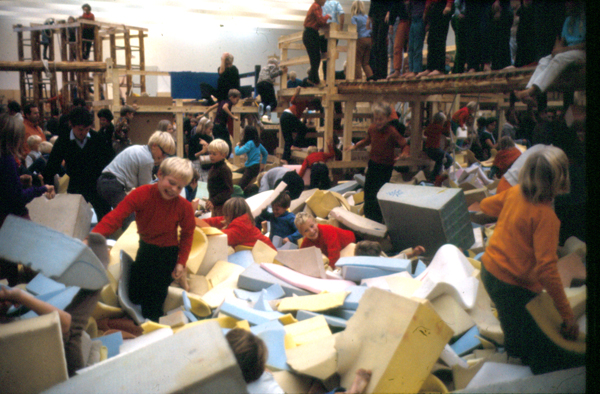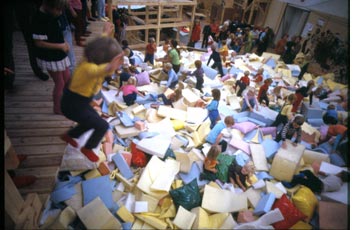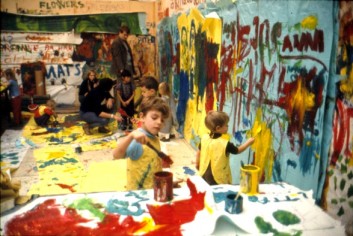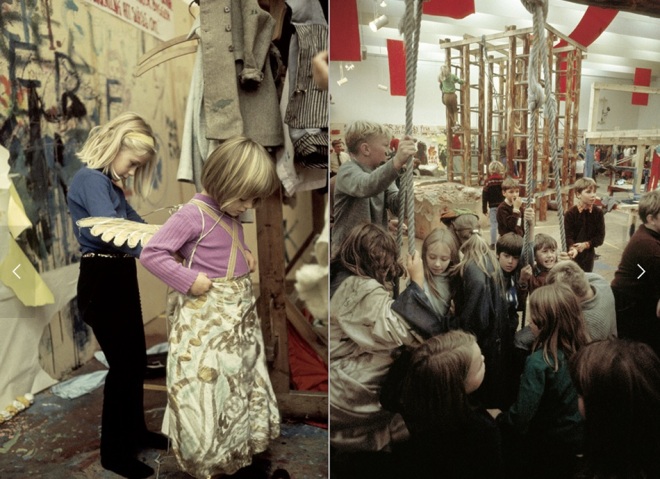In 1968 the Moderna Museet, Stockholm and artist Palle Nielsen staged The Model, a radical social experiment involving 20,000 children, an indoor playground and no rules. Within the ‘exhibition’ the act of children playing was used as an instrument for social and political activism. This post features a study of The Model and Nielsen’s work as an artist, educator and social activist.

In 1968 Danish artist Palle Nielsen exhibited a giant adventure playground in the main gallery of the Moderna Museet, Stockholm. The Model – A Model for A Qualitative Society was a free play zone in which children could jump off bridges into a foam pit, swing from tyres, make things out of DIY tools such as hammers and saws, climb rope swings, paint, wear dress-ups and use turntables to mix music being played on loudspeakers. From September 30 – October 20 1968, the exhibition saw 35,000 visitors with 20,000 of them being children. The artist intended to reject an elitist concept of art and art museum through the ‘creation of a collectivist human being.’

“I wanted to deconstruct ‘the white cube’ as the idea of an art museum… The idea of an art museum was to be changed by the live presence of active, playing children in the museum.”
The exhibition was free to all visitors under the age of 18. Kindergartens and school groups from all over Stockholm were invited to visit the exhibition in a grand attempt to integrate new members of the community into the gallery space. The Model sat between a pedagogical project, a process- driven art installation and political protest against the art gallery as a space for the social elite.
Prior to creating The Model, Nielsen had been building unauthorised adventure playgrounds in disadvantaged areas of Copenhagen. A practice which he saw as the mobilisation of children as agents of democratic activism through play. After a period of fundraising and negotiations with the Director of the Modern Museet, Nielsen constructed The Model with the assistance of children and anti-Vietnam War activists.
Scandinavia in the 1960’s and 70’s saw the rise of a progressive child-centered education movement that dismissed the idea of children as passive beings in the community. Whilst the movement had strong roots in left-wing politics, the intention of the education reform was not radical social transformation but to create a new social framework that valued children as active beings and creators of their own lives. At its core, Nielsen had created a space which unleashed the anarchic act of creative play as a tool for the activation of children’s right to freedom of expression. However unlike the anti-Vietnam war demonstrations of the time, The Model empowered children though its ability to connect individuals with themselves, their environment and others in the community. The exhibition statement read:

‘The idea is to create a framework for children’s own creative play. Children of all ages will work on developing this framework. Indoors and outdoors – in all kinds of play – they should have the right to communicate their capacity for self-expression. Their play is the exhibition. The exhibition is the work of children. There is no exhibition. It is only an exhibition because the children are playing in an art museum. It is only an exhibition for those who are not playing. That’s why we call it a model. Perhaps it will be the model for the society children want. Perhaps children can tell us so much about their own world that this can also be a model for us. We hope so. Therefore, we are letting the children present their model to those who are working with or are responsible for the environment provided for children outside – in the adult world. We believe children are capable of articulating their own needs. And that they want something different from what awaits them.’
Following The Model Nielsen was shunted from the Danish art academy where he was completing his PhD in architecture. After continuous criticism from critics and increasing isolation from the art world he left the academy to become a teacher in adult and community education centers in Denmark. In 1998 he was contacted by art critic Lars Bang Larsen who was writing a paper on The Model for an art journal. In a wave of resurgent interest in his art practice, Nielsen agreed to donate the documentation of the project to Museu d’Art Contemporani de Barcelona. The documentation was exhibited at MACBA (2010) and Tate Liverpool (2014). A replica of The Model was presented at the ARKEN Museum for Moderne Kunst, Denmark from February 9 – December 7, 2014.
